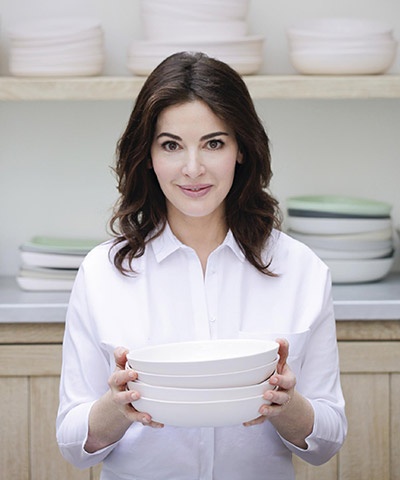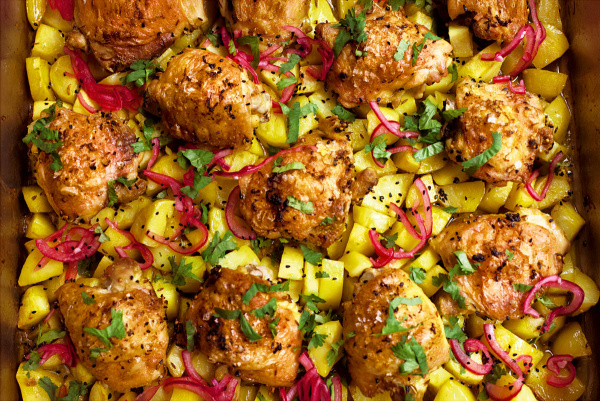Malaysian Red-Cooked Chicken
by Nigella. Featured in SIMPLY NIGELLAIntroduction
Yasmin Othman is my patient teacher in the arts of Malaysian cooking, and I am grateful to her. This, properly called ayam masak merah, gets its red colour as much from the fiery chilli paste at its base as from the tomatoes. In fact, when I posted a picture of my first attempt online, I was strictly enjoined by a chorus of Malaysians to add more chillies. They could tell my error just by the colour. Yes, it is hot, but not frighteningly so, yet what is more unfamiliar is the desirably dry texture of the curry. Dry, in the context of curries, and more particularly here, simply means that the chicken mustn’t swim in a sauce, but be thickly coated by it. I require nothing more alongside it than plain rice.
Yasmin Othman is my patient teacher in the arts of Malaysian cooking, and I am grateful to her. This, properly called ayam masak merah, gets its red colour as much from the fiery chilli paste at its base as from the tomatoes. In fact, when I posted a picture of my first attempt online, I was strictly enjoined by a chorus of Malaysians to add more chillies. They could tell my error just by the colour. Yes, it is hot, but not frighteningly so, yet what is more unfamiliar is the desirably dry texture of the curry. Dry, in the context of curries, and more particularly here, simply means that the chicken mustn’t swim in a sauce, but be thickly coated by it. I require nothing more alongside it than plain rice.

Share or save this
Ingredients
Serves: 4-6
- 6 long dried red chillies (not the small dried bird’s eye chillies)
- 1 large red onion (peeled and roughly chopped)
- 3 cloves garlic (peeled and roughly chopped)
- 5 centimetres (25g) fresh ginger (peeled and sliced)
- 3 fresh red chillies (roughly chopped with seeds intact)
- 2 x 15ml tablespoons sunflower oil
- 2 sticks lemongrass (trimmed and bruised)
- 3 x 15ml tablespoons tomato puree
- 12 chicken thighs (bone in and skin removed)
- 1 x 400 grams can chopped tomatoes
- 200 millilitres coconut milk
- ½ teaspoon Maldon sea salt flakes
TO SERVE
- 2 shallots (peeled and thinly sliced)
- 3 - 4 x 15ml tablespoons sunflower oil
- 6 long dried red chiles (not the small dried bird’s eye chillies)
- 1 large red onion (peeled and roughly chopped)
- 3 cloves garlic (peeled and roughly chopped)
- 2 inches (25g) fresh gingerroot (peeled and sliced)
- 3 fresh red chiles (roughly chopped with seeds intact)
- 2 tablespoons vegetable oil
- 2 sticks lemongrass (trimmed and bruised)
- 3 tablespoons tomato puree
- 12 chicken thighs (bone in and skin removed)
- 1 x 14 ounces can diced tomatoes
- 1 cup coconut milk
- ½ teaspoon kosher salt
TO SERVE
- 2 shallots (peeled and thinly sliced)
- 3 - 4 tablespoons vegetable oil
Method
- Soak the dried chillies in hot water for 5 minutes to soften; many will float rather than be submerged by the water. Remove them from the water, tearing into pieces — best to use disposable vinyl CSI gloves for this — and shake out as many seeds as possible.
- Blitz the onion, garlic and ginger into a paste with the fresh red chillies and soaked dried chillies in a bowl with a stick blender.
- In a large wok (that comes with a lid), heat the oil, then add the just-blitzed-up chilli paste and bruised lemongrass to the wok and fry for 5 minutes over a medium heat, stirring every now and again.
- Add the tomato purée and fry for 1 minute, then add the chicken thighs to the pan, stirring to coat them well in the mixture.
- Add the canned tomatoes, then add water from the cold tap to the empty can so that it is quarter-filled, then swill the can and pour the water into the wok, followed by the coconut milk, stir well and add the salt.
- Bring to the boil, then cover with a lid, turn down the heat and leave to simmer for 30 minutes, lifting the lid every so often to stir the chicken in the sauce.
- Remove the lid, turn the heat up a little and cook, uncovered, at a bold simmer for 30 minutes; the sauce will start to thicken and become a deeper red. Transfer to a dish to cool, and refrigerate, covered, for at least 1 day and up to 3 days (see Additional Info, below).
- To reheat, put the chicken in its sauce back in the wok, put on the lid, and cook over a medium to low heat until the chicken is hot all the way through, about 20 minutes, lifting the lid to stir every so often to make sure the heat is evenly distributed. Remove the lid, turn up the heat and let the sauce bubble away for about 15 minutes, so it becomes more like a thick paste that sticks to the chicken thighs. Once the sauce is the right consistency, taste and add more salt if you wish.
- You don't have to sprinkle crisp shallot rings over the top, but you will be glad if you do. Heat the oil in a cast-iron or heavy-based frying pan and fry the sliced shallots until they are golden and crisp. As soon as they are cooked, carefully transfer to some kitchen roll and leave to cool. Indeed, you can cook these at any time while the chicken's cooking, or even before. Sprinkle over the red-cooked chicken on serving.
- Soak the dried chillies in hot water for 5 minutes to soften; many will float rather than be submerged by the water. Remove them from the water, tearing into pieces — best to use disposable vinyl CSI gloves for this — and shake out as many seeds as possible.
- Blitz the onion, garlic and ginger into a paste with the fresh red chiles and soaked dried chillies in a bowl with a stick blender.
- In a large wok (that comes with a lid), heat the oil, then add the just-blitzed-up chilli paste and bruised lemongrass to the wok and fry for 5 minutes over a medium heat, stirring every now and again.
- Add the tomato purée and fry for 1 minute, then add the chicken thighs to the pan, stirring to coat them well in the mixture.
- Add the canned tomatoes, then add water from the cold tap to the empty can so that it is quarter-filled, then swill the can and pour the water into the wok, followed by the coconut milk, stir well and add the salt.
- Bring to the boil, then cover with a lid, turn down the heat and leave to simmer for 30 minutes, lifting the lid every so often to stir the chicken in the sauce.
- Remove the lid, turn the heat up a little and cook, uncovered, at a bold simmer for 30 minutes; the sauce will start to thicken and become a deeper red. Transfer to a dish to cool, and refrigerate, covered, for at least 1 day and up to 3 days (see Additional Info, below).
- To reheat, put the chicken in its sauce back in the wok, put on the lid, and cook over a medium to low heat until the chicken is hot all the way through, about 20 minutes, lifting the lid to stir every so often to make sure the heat is evenly distributed. Remove the lid, turn up the heat and let the sauce bubble away for about 15 minutes, so it becomes more like a thick paste that sticks to the chicken thighs. Once the sauce is the right consistency, taste and add more salt if you wish.
- You don't have to sprinkle crisp shallot rings over the top, but you will be glad if you do. Heat the oil in a cast-iron or heavy-based frying pan and fry the sliced shallots until they are golden and crisp. As soon as they are cooked, carefully transfer to some kitchen roll and leave to cool. Indeed, you can cook these at any time while the chicken's cooking, or even before. Sprinkle over the red-cooked chicken on serving.
Additional Information
MAKE AHEAD:
The shallots can be fried up to 4 hours ahead. Leave at cool room temperature until needed. The curry paste can be made 2 days ahead then covered and stored in fridge until needed. The chicken curry (without shallots) can be made up to 3 days ahead. Cool, cover and refrigerate within 2 hours of making. Will keep in fridge for up to 3 days. Reheat as per recipe, above.
FREEZE:
Freeze in an airtight container for up to 2 months. Defrost overnight in fridge and reheat as above.
NOTE: the chicken should be reheated once only.
MAKE AHEAD:
The shallots can be fried up to 4 hours ahead. Leave at cool room temperature until needed. The curry paste can be made 2 days ahead then covered and stored in fridge until needed. The chicken curry (without shallots) can be made up to 3 days ahead. Cool, cover and refrigerate within 2 hours of making. Will keep in fridge for up to 3 days. Reheat as per recipe, above.
FREEZE:
Freeze in an airtight container for up to 2 months. Defrost overnight in fridge and reheat as above.
NOTE: the chicken should be reheated once only.







Tell us what you think
Thank you {% member.data['first-name'] %}.
Explore more recipesYour comment has been submitted.
What 1 Other has said
-
Posted by LT123 on 23rd July 2022
Show more commentsAmazing recipe, and simple too with such few ingrediants! Must admit I couldn't quite follow it to the letter as I didn't have 24hrs to spare to leave the dish to rest before reheating - I 'think' I remedied this by thickening it up using extra ingredients and serving it at stage 7 as is. I added a very finely chopped leek (needing using up) with the chicken, I also added half a roughly chopped cauliflower (cauli goes beaut with any Asian or Indian dishes imo) 20 mins after the chicken, and then some finely chopped cabbage (also needed using up) 10 mins before the end game, and I feel this reduced everything down to what it would've been if I'd followed the extra steps of waiting, leaving a nice, varied, bulked out flavourful dish. Maybe not as intensely flavoured as leaving it to steep for the detailed time but still lovely. Served with rice and poppadoms and home grown romaine lettuce for crunch and freshness against the rich sauce.